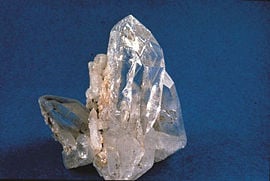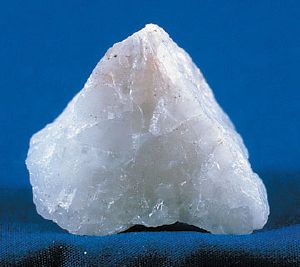Difference between revisions of "Quartz" - New World Encyclopedia
(added credit and category tags, deleted foreign language links) |
(editing) |
||
| Line 76: | Line 76: | ||
| [[Carnelian]] || Reddish orange chalcedony, translucent | | [[Carnelian]] || Reddish orange chalcedony, translucent | ||
|} | |} | ||
| − | '''Quartz''' is one of the most common [[mineral]]s in the [[Earth]]'s | + | '''Quartz''' is one of the most common [[mineral]]s in the [[Earth]]'s continental crust. It has a [[hexagonal (crystal system)|hexagonal]]* [[crystal]] structure made of [[trigonal]]* crystallized [[silica]] (silicon dioxide, SiO<sub>2</sub>), with a hardness (resistance to scratching) of 7 on the [[Mohs scale]]* of 1 to 10. Its [[density]] is 2.65 g/cm³. The typical shape of the crystal ("crystal habit") is a six-sided [[prism (geometry)|prism]] that ends in six-sided [[pyramid]]s. The crystals, however, are often twinned, distorted, or so massive that only part of the shape is apparent from a mined specimen. Additionally, the crystals may take the form of a ''bed'', particularly for varieties such as [[amethyst]], in which the crystals grow up from a matrix and only one termination pyramid appears. A quartz [[geode]] consists of a hollow rock (usually with a roughly spherical shape) containing a core lined with a bed of crystals. |
==Varieties== | ==Varieties== | ||
| − | |||
| − | + | Quartz is one of the world's most common crustal minerals and goes by a bewildering array of names. | |
| + | Some types of quartz have a "macrocrystalline" structure, in which individual crystals are visible to the unaided eye, while other types of quartz have a "microcrystalline" or "cryptocrystalline" structure, in which aggregates of crystals are visible only under high magnification. [[Chalcedony]]* is a generic term for cryptocrystalline quartz. The cryptocrystalline varieties are translucent or mostly opaque, while the transparent varieties tend to be macrocrystalline. | ||
| − | + | Although many of the varietal names historically arose from the mineral's color, current scientific naming schemes refer primarily to the mineral's microstructure. Color is a secondary identifier for the cryptocrystalline minerals, although it is a primary identifier for the macrocrystalline varieties. This does not always hold true. | |
| − | |||
| − | + | Not all varieties of quartz are naturally occurring. Prasiolite, an olive colored material, is produced by heat treatment; natural prasiolite has also been obeserved in Lower Silesia in Poland. Although [[citrine]]* occurs naturally, the majority is the result of heat-treated amethyst. [[Carnelian]]* is widely heat-treated to deepen its color. | |
| + | |||
| + | [[Image:QuartzUSGOV.jpg|left|thumb|Milk quartz.]] | ||
| + | |||
| + | Given that natural quartz is often [[crystal twinning|twinned]], much quartz used in industry is synthesized. Large, flawless and untwinned crystals are produced in an [[autoclave]] via the [[hydrothermal]] process: [[emerald]]s are also synthesized in this manner. | ||
Quartz occurs in [[Vein_(geology)|hydrothermal veins]] and [[pegmatite]]s. Well-formed crystals may reach several metres in length and [[mass|weigh]] hundreds of kilograms. These veins may bear [[precious metals]] such as [[gold]] or [[silver]], and form the quartz ores sought in [[mining]]. Erosion of pegmatites may reveal expansive pockets of crystals, known as "cathedrals." | Quartz occurs in [[Vein_(geology)|hydrothermal veins]] and [[pegmatite]]s. Well-formed crystals may reach several metres in length and [[mass|weigh]] hundreds of kilograms. These veins may bear [[precious metals]] such as [[gold]] or [[silver]], and form the quartz ores sought in [[mining]]. Erosion of pegmatites may reveal expansive pockets of crystals, known as "cathedrals." | ||
Revision as of 14:31, 1 June 2006
- For other uses, see Quartz (disambiguation).
| Quartz | |
|---|---|

| |
| General | |
| Category | Mineral |
| Chemical formula (or Composition) | Silica (silicon dioxide, SiO2) |
| Identification | |
| Color | Clear (if no impurities); also see Varieties |
| Crystal habit | 6-sided prism ending in 6-sided pyramid (typical) |
| Crystal system | Hexagonal |
| Cleavage | None |
| Fracture | Conchoidal |
| Mohs Scale hardness | 7 - lower in impure varieties |
| Luster | Vitreous/glossy |
| Refractive index | 1.544-1.553 - DR +0.009 (B-G interval) |
| Pleochroism | None |
| Streak | White |
| Specific gravity | 2.65 constant; variable in impure varieties |
| Melting point | 1650 (±75) °C |
| Boiling point | 2230 °C |
| Solubility | H2O insoluble |
| Major varieties | |
| Chalcedony | Any cryptocrystalline quartz, although generally only used for white or lightly coloured material. Otherwise more specific names are used. |
| Agate | Banded Chalcedony, translucent |
| Onyx | Agate where the bands are straight, parallel and consistent in size. |
| Jasper | Opaque chalcedony, impure |
| Aventurine | Translucent chalcedony with small inclusions (usually mica) that shimmer. |
| Tiger's eye | Fibrous quartz, exhibiting chatoyancy. |
| Rock Crystal | Clear, colourless |
| Ruby Quartz | Crimson glass-like crystal, absorbs vast amounts of solar energy |
| Amethyst | Purple, transparent |
| Citrine | Yellow to reddish orange, greenish yellow |
| Prasiolite | Mint green, transparent |
| Rose quartz | Pink, translucent, may display diasterism |
| Milk quartz, or snow quartz | White, translucent to opaque, may display diasterism |
| Smoky quartz | Brown, transparent |
| Morion | Dark-brown, opaque |
| Carnelian | Reddish orange chalcedony, translucent |
Quartz is one of the most common minerals in the Earth's continental crust. It has a hexagonal crystal structure made of trigonal crystallized silica (silicon dioxide, SiO2), with a hardness (resistance to scratching) of 7 on the Mohs scale of 1 to 10. Its density is 2.65 g/cm³. The typical shape of the crystal ("crystal habit") is a six-sided prism that ends in six-sided pyramids. The crystals, however, are often twinned, distorted, or so massive that only part of the shape is apparent from a mined specimen. Additionally, the crystals may take the form of a bed, particularly for varieties such as amethyst, in which the crystals grow up from a matrix and only one termination pyramid appears. A quartz geode consists of a hollow rock (usually with a roughly spherical shape) containing a core lined with a bed of crystals.
Varieties
Quartz is one of the world's most common crustal minerals and goes by a bewildering array of names. Some types of quartz have a "macrocrystalline" structure, in which individual crystals are visible to the unaided eye, while other types of quartz have a "microcrystalline" or "cryptocrystalline" structure, in which aggregates of crystals are visible only under high magnification. Chalcedony is a generic term for cryptocrystalline quartz. The cryptocrystalline varieties are translucent or mostly opaque, while the transparent varieties tend to be macrocrystalline.
Although many of the varietal names historically arose from the mineral's color, current scientific naming schemes refer primarily to the mineral's microstructure. Color is a secondary identifier for the cryptocrystalline minerals, although it is a primary identifier for the macrocrystalline varieties. This does not always hold true.
Not all varieties of quartz are naturally occurring. Prasiolite, an olive colored material, is produced by heat treatment; natural prasiolite has also been obeserved in Lower Silesia in Poland. Although citrine occurs naturally, the majority is the result of heat-treated amethyst. Carnelian is widely heat-treated to deepen its color.
Given that natural quartz is often twinned, much quartz used in industry is synthesized. Large, flawless and untwinned crystals are produced in an autoclave via the hydrothermal process: emeralds are also synthesized in this manner.
Quartz occurs in hydrothermal veins and pegmatites. Well-formed crystals may reach several metres in length and weigh hundreds of kilograms. These veins may bear precious metals such as gold or silver, and form the quartz ores sought in mining. Erosion of pegmatites may reveal expansive pockets of crystals, known as "cathedrals."
Quartz is a common constituent of granite, sandstone, limestone, and many other igneous, sedimentary, and metamorphic rocks.
Tridymite and cristobalite are high temperature polymorphs of SiO2 which occur in high silica volcanic rocks. Lechatelierite is an amorphous silica glass SiO2 which is formed by lightning strikes in quartz sand.
History
The name "quartz" comes from the German "Quarz", which is of Slavic origin (Czech miners called it křem). Other sources insist the name is from the Saxon word "Querkluftertz", meaning cross-vein ore.
Quartz is the most common material identified as the mystical substance maban in Australian Aboriginal mythology.
Roman naturalist Pliny the Elder believed quartz to be permanently frozen ice. He supported this idea by saying that quartz is found near glaciers in the Alps and that large quartz crystals were fashioned into spheres to cool the hands. He also knew of the ability of quartz to split light into a spectrum.
Nicolas Steno's study of quartz paved the way for modern crystallography. He discovered that no matter how distorted a quartz crystal, the long prism faces always made a perfect 60 degree angle.
Charles Sawyer invented the commercial quartz crystal manufacturing process in Cleveland, OH. This initiated the transition from mined and cut quartz for electrical appliances to manufactured quartz.
Piezoelectricity
Quartz is also a type of piezoelectric crystal that creates electricity through a process called piezoelectricity when mechanical stress is put upon it. One of the earliest uses for a quartz crystal was a phonograph pickup. Today, one of the most ubiquitous piezoelectric uses of quartz is as a crystal oscillator — in fact these oscillators are often simply called "quartzes". The same principle is also used for very accurate measurements of very small mass changes by means of the quartz crystal microbalance.
See also
- Fused quartz
- List of minerals
- Shocked quartz
ReferencesISBN links support NWE through referral fees
- Hurlbut, Cornelius S.; Klein, Cornelis, 1985, Manual of Mineralogy, 20th ed., ISBN 0471805807
- Quartz group - Mineral Galleries
- Quartz - Mineral Galleries
- Quartz - Mineral.net
- Arkansas quartz, Rockhounding Arkansas
- Gilbert Hart Nomenclature of Silica, American Mineralogist, Volume 12, pages 383-395, 1927
- Mindat.org
- Queensland University of Technology Origin of the word quartz.
- PDF of Charles Sawyer's cultured quartz process description
Credits
New World Encyclopedia writers and editors rewrote and completed the Wikipedia article in accordance with New World Encyclopedia standards. This article abides by terms of the Creative Commons CC-by-sa 3.0 License (CC-by-sa), which may be used and disseminated with proper attribution. Credit is due under the terms of this license that can reference both the New World Encyclopedia contributors and the selfless volunteer contributors of the Wikimedia Foundation. To cite this article click here for a list of acceptable citing formats.The history of earlier contributions by wikipedians is accessible to researchers here:
The history of this article since it was imported to New World Encyclopedia:
Note: Some restrictions may apply to use of individual images which are separately licensed.


